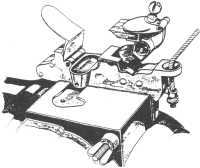The Gun - Smoothbore Era 1550-1860: Firing the GunGuns were first fired by a red-hot iron thrust down the vent. This method worked well but required a fire on the gun position, rather dangerous with loose serpentine powder, the dust from which could be ignited by the smallest spark or even by friction. Next came the 'slow match', a cord soaked in spirits or some mixture which enabled it to burn very slowly. It was held by a linstock. At first the slow match was taken to the gun on the linstock and applied to the vent, the latter having been primed with loose powder. Flame from the priming in turn ignited the propellant charge in the chamber. | |
|
The methods described caused progressive erosion of the vent, leading to a reduction in propellant gas pressure with a consequent loss in muzzle velocity. To repair the damage, vents had to be bored out and re-bushed, a time-consuming process in the smooth-bore era. To overcome the problem, in 1697 metal tubes were introduced. At first they contained quickmatch but this was later replaced by powder. The tube was inserted in the vent and the contents ignited in the same way as loose priming. The use of the tubes also enabled the rate of fire to be increased. |
  Linstocks |
|
| |
Common TubesWe have already learned that to prevent erosion of vents metal tubes were introduced in 1697. These were filled with mealed powder dampened with methylated spirits, while the top, formed into a cup, was filled with a mixture of mealed powder, gum and water made into a paste and sprinkled on top with dry powder. This cup was covered with a paper cover which had to be removed before use. Having been inserted in the vent the tube's contents were ignited in the normal manner (by portefire after 1700). The tubes worked very well but the Navy complained that fired tubes lying on the decks might injure sailors' bare feet, so in 1778 (change came slowly in those days) adopted tubes made of goose quill. Almost identical in shape and size to the metal variety they worked equally well, but though they saved sailors' feet they did not save gun vents. As the quill burned completely away on firing, vent erosion was as bad as before. |
 metal tube (left) quill tube (right) |
Flintlock
Friction Tubes
Friction tubes were still in use in BL field guns until they were superseded by QF types during the South African War (1899-1902). NZAOC still had them in store in 1938 when they produced some for the makers of the film 'Rewi's Last Stand'! Percussion TubesIn 1830 James Marsh invented the percussion tube and in 1832 the first ship HMS Castor had her guns modified for them. They were not approved for the Army until 1845, when Woolwich commenced their manufacture - for coast artillery only. They became obsolete in 1866.Electric TubesIn 1862 Sir Frederick Abel invented an electric tube for use in coast artillery. Approved for issue in 1866 it was known as 'tube electric high tension' and worked on the same principle as the modern spark plug. Ignition was by spark via a gap between two wires buried in a special priming composition, not by an incandescent wire bridge. Power came from a portable generator.
This now completes the history of smooth-bore ordnance and ammunition. The following pages deal with rifled ordnance.
WL Ruffell, 1997 previous | index | next | History index | Home | |
 In 1778 Sir Chas Douglas urged the adoption of flintlocks for naval ordnance but the RN would not listen. He therefore bought musket locks for the guns on his own ship where he proved their superiority to other forms of ignition. Twelve years later the Admiralty were convinced and adopted them in 1790. However, the Army did not adopt them until 1820 - and even then retained their portefires 'just in case'.
In 1778 Sir Chas Douglas urged the adoption of flintlocks for naval ordnance but the RN would not listen. He therefore bought musket locks for the guns on his own ship where he proved their superiority to other forms of ignition. Twelve years later the Admiralty were convinced and adopted them in 1790. However, the Army did not adopt them until 1820 - and even then retained their portefires 'just in case'. Often called 'T' friction tubes from their shape, friction tubes were introduced in 1853. Filling was similar to that of common tubes. Ignition was by flash produced by a roughened bar at the top reacting with a sensitive igniter in the neck when pulled by a lanyard attached to the ring.
Often called 'T' friction tubes from their shape, friction tubes were introduced in 1853. Filling was similar to that of common tubes. Ignition was by flash produced by a roughened bar at the top reacting with a sensitive igniter in the neck when pulled by a lanyard attached to the ring.